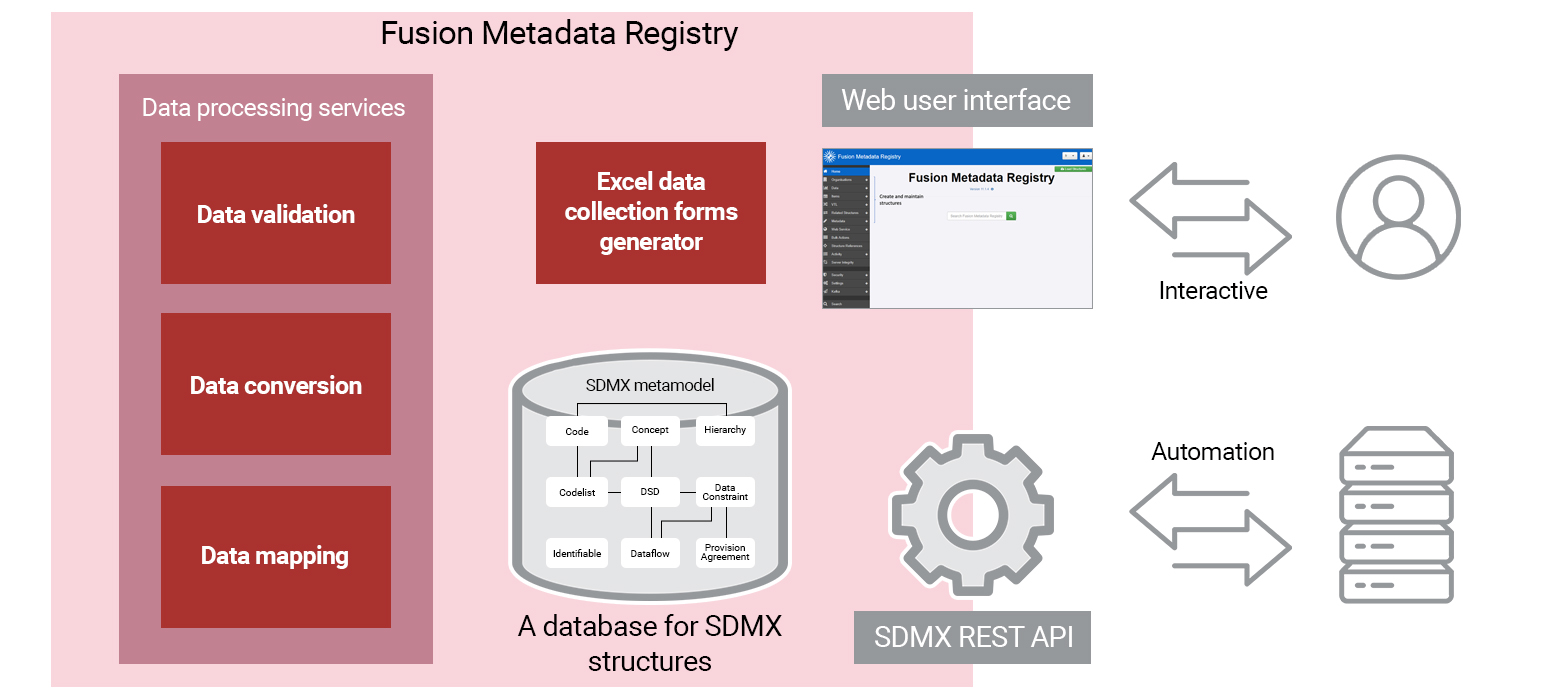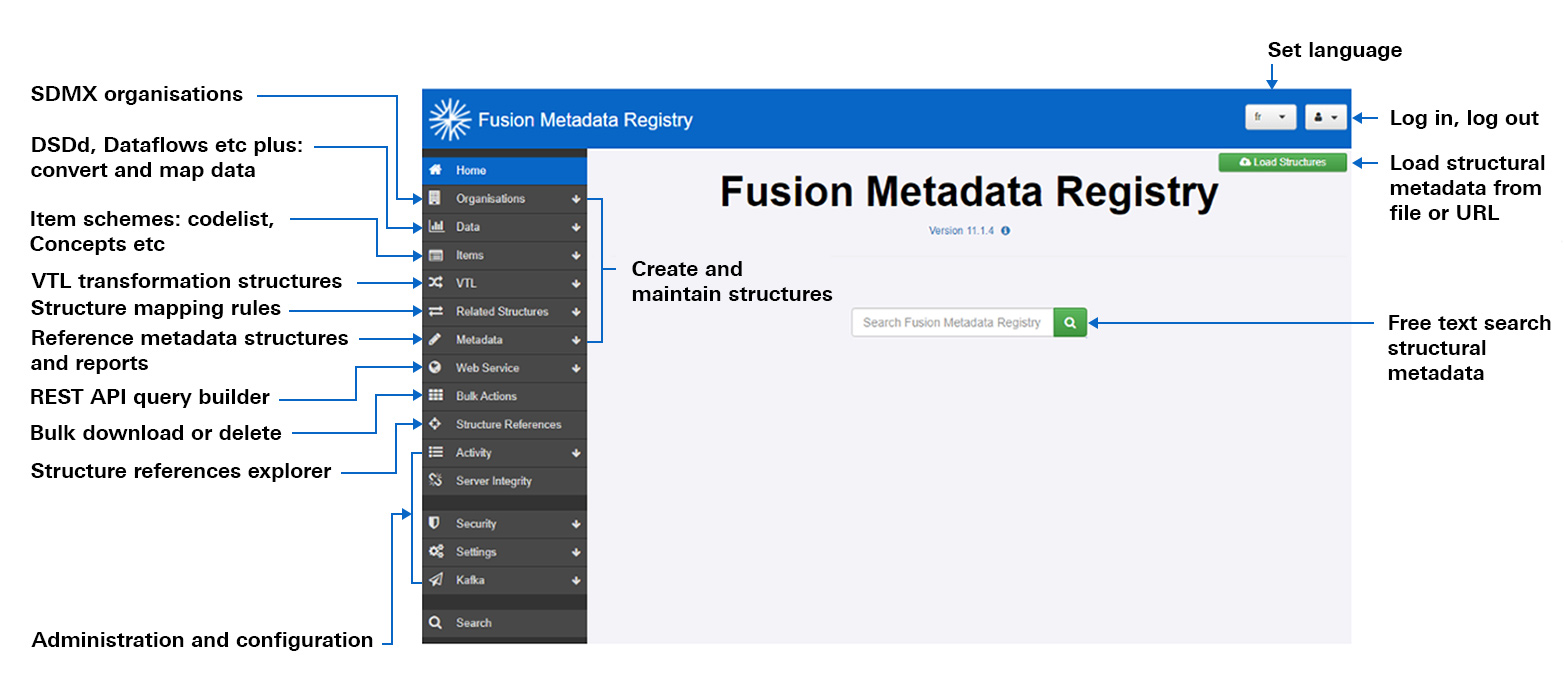Unit 2: Introduction to the Fusion Metadata Registry (FMR)

This unit defines what an SDMX structural metadata registry is and then proceeds to introduce the Fusion Metadata Registry (FMR) and the full range of statistical use cases that FMR addresses.
What is an SDMX structural metadata registry?
Explicitly, we are referring to the following:

- Structural metadata: All SDMX structures, e.g. concepts, codelists, data structure definitions. Plus: reference metadata reports which are treated like structures in SDMX 3.0.
- Metadata registry: Wikipedia: “A metadata registry is a central location in an organisation where metadata definitions are stored and maintained in a controlled method.”
- SDMX specification: The SDMX ‘metamodel’. Note SDMX uses the term ‘information model’ rather than ‘metamodel’.
In essence, therefore, an SDMX structural metadata registry is a:
- central location in an organisation where
- SDMX metadata definitions (i.e. structures plus reference metadata reports) are
- stored and maintained in a controlled method.
What is the FMR?
FMR is an SDMX registry implementation which supports multiple versions of SDMX, including SDMX 2.0, 2.1 and 3.0.
The FMR tool provides robust value-added capabilities to support data production, data collection, and data reporting/dissemination processes.
Watch this introductory video of Fusion Metadata Registry (FMR) to learn more about this product.
Select each of the principle FMR use cases to discover more.
- Externalise and centralise metadata
- Metadata governance – gain control
- Improve metadata maintainability
- Metadata reuse
- Harmonisation of concepts
- Interactively create and modify SDMX structures using the web user interface
- Programmatically create, modify, and retrieve SDMX structures using the SDMX REST API
- Publish structural metadata for data reporters
- Generate Excel data reporting forms
- Validate received datasets
- Validate SDMX data prior to submission
- Convert data between SDMX formats
- Data mapping – transform data to the collector’s data structure definition (DSD)
FMR principles in practice
The heart of Fusion Metadata Registry is its structural metadata repository - essentially a database that implements the SDMX 3.0 information model.
All structural metadata objects are stored according to this model which provides a rigorous dependency graph that defines and enforces the metadata’s referential integrity. This strongly enforced referential integrity provides confidence that the metadata model is always complete – a DSD for instance can never exist without its referenced Codelists.
The diagram below shows visual representation of the FMR principal use cases.
Select the diagram to enlarge.


FMR tool interface
The image below shows the FMR tool’s main screen and provides an indication of what each item on the screen relates to.
In this module, we’ll go over the tool’s key menu options, so that you can use it to create and manage the essential SDMX structures. In practice, you’ll only be able to create or change structural metadata by first being logged in to the tool. So, one key takeaway is to note the location of the Log in, log out feature in the top right corner of the image.
Select the image to enlarge.


What do you know?
Now that you’ve completed our Introduction to the Fusion Metadata Registry, try this.
The FMR tool provides robust value-added capabilities to support which of the following?
Select all that apply and then select Submit.
All the options are correct!
The FMR tool provides robust value-added capabilities to support data production, data collection, and data reporting/dissemination processes, including data description and data validation sub-processes.
All the options are correct!
The FMR tool provides robust value-added capabilities to support data production, data collection, and data reporting/dissemination processes, including data description and data validation sub-processes.
All the options are correct!
The FMR tool provides robust value-added capabilities to support data production, data collection, and data reporting/dissemination processes, including data description and data validation sub-processes.
Coming next …
This overview of an SDMX registry and the features and capabilities of the most popular SDMX registry, FMR, has provided the foundation for the following units in this module where an SDMX Logical Model will be entered into FMR and made available for use in statistics production processes.